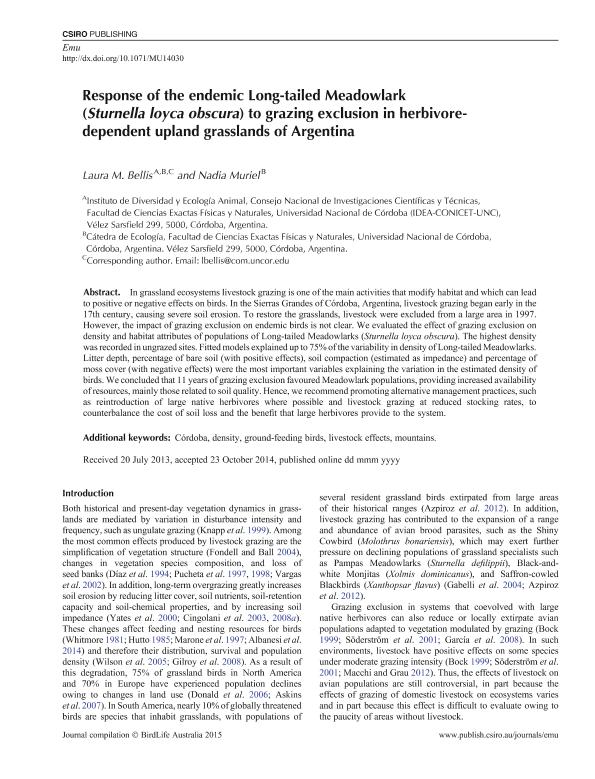Artículo
Response of the endemic Long-tailed Meadowlark (Sturnella loyca obscura) to grazing exclusion in herbivore-dependent upland grasslands of Argentina
Fecha de publicación:
04/2015
Editorial:
Csiro Publishing
Revista:
Emu
ISSN:
0158-4197
Idioma:
Inglés
Tipo de recurso:
Artículo publicado
Clasificación temática:
Resumen
In grassland ecosystems livestock grazing is one of the main activities that modify habitat and which can lead to positive or negative effects on birds. In the Sierras Grandes of Córdoba, Argentina, livestock grazing began early in the 17th century, causing severe soil erosion. To restore the grasslands, livestock were excluded from a large area in 1997. However, the impact of grazing exclusion on endemic birds is not clear. We evaluated the effect of grazing exclusion on density and habitat attributes of populations of Long-tailed Meadowlarks (Sturnella loyca obscura). The highest density was recorded in ungrazed sites. Fitted models explained up to 75% of the variability in density of Long-tailed Meadowlarks. Litter depth, percentage of bare soil (with positive effects), soil compaction (estimated as impedance) and percentage of moss cover (with negative effects) were the most important variables explaining the variation in the estimated density of birds. We concluded that 11 years of grazing exclusion favoured Meadowlark populations, providing increased availability of resources, mainly those related to soil quality. Hence, we recommend promoting alternative management practices, such as reintroduction of large native herbivores where possible and livestock grazing at reduced stocking rates, to counterbalance the cost of soil loss and the benefit that large herbivores provide to the system.
Palabras clave:
Abundance
,
Grasslands
,
Livestock Grazing
,
Sturnella Loyca Obscura
Archivos asociados
Licencia
Identificadores
Colecciones
Articulos(IDEA)
Articulos de INSTITUTO DE DIVERSIDAD Y ECOLOGIA ANIMAL
Articulos de INSTITUTO DE DIVERSIDAD Y ECOLOGIA ANIMAL
Citación
Bellis, Laura Marisa; Muriel, Nadia; Response of the endemic Long-tailed Meadowlark (Sturnella loyca obscura) to grazing exclusion in herbivore-dependent upland grasslands of Argentina; Csiro Publishing; Emu; 115; 2; 4-2015; 176-184
Compartir
Altmétricas




